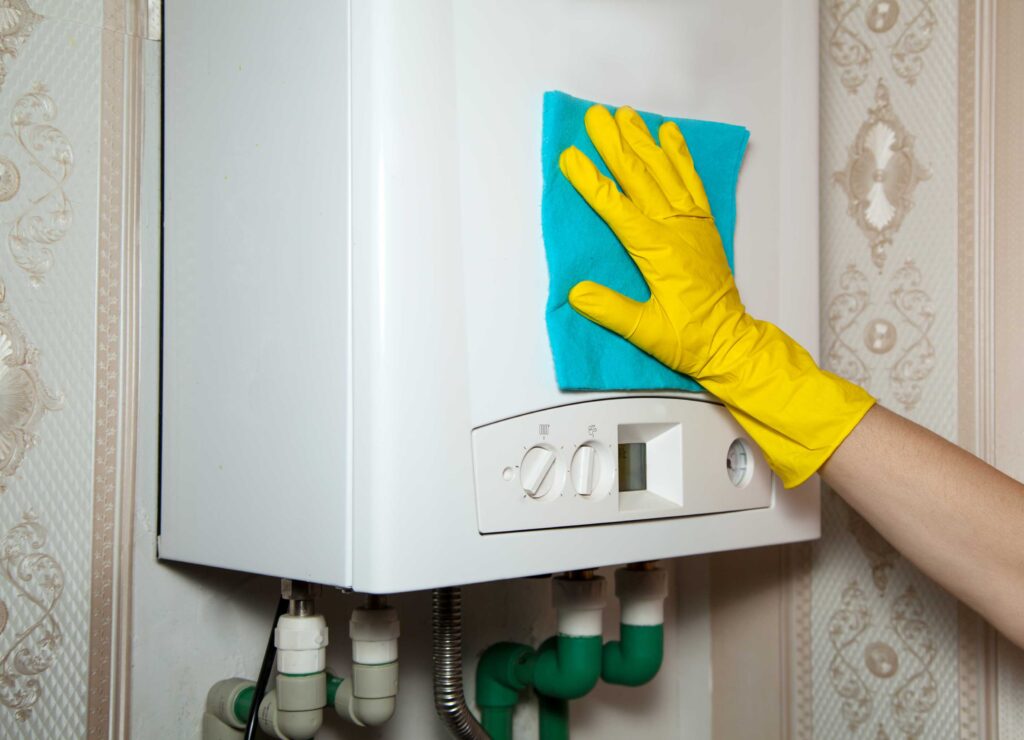Tankless water heaters provide efficient hot water on demand, but regular maintenance is crucial for optimal performance. Over time, mineral buildup can reduce efficiency and lead to issues. This guide will walk you through cleaning Rinnai tankless water heater, using a Rinnai tankless water heater flush kit, and flushing it with vinegar.
Why Cleaning Rinnai Tankless Water Heater is Important
Regular maintenance prevents limescale buildup, ensures energy efficiency, and extends the unit’s lifespan. Following the Rinnai tankless water heater maintenance manual can help avoid costly repairs and keep your system running smoothly. Cleaning tankless water heater properly helps maintain its efficiency and prevents damage caused by scale deposits.
Step 1: Gather the Necessary Supplies
Before starting, ensure you have the following:
- Rinnai tankless water heater flush kit
- 4 gallons of white vinegar
- Two washing machine hoses
- A submersible pump
- A 5-gallon bucket
- Protective gloves and eyewear
Having the right tools makes the process of cleaning Rinnai tankless water heater easier and ensures a thorough job. A tankless water heater flush kit is essential for removing mineral buildup.
Step 2: Turn Off Power and Water Supply
Shut off the gas supply or turn off the circuit breaker for electric models. Close the three water valves connected to your heater. This ensures safety before beginning the cleaning process. Cleaning tankless water heater requires taking safety precautions to avoid accidental leaks or electrical issues.
Step 3: Attach Hoses to Purge Valves
Locate the hot and cold water purge valves and slowly remove their caps. Attach hoses from your Rinnai tankless water heater flush kit to both valves, ensuring a secure connection. This step is critical for allowing the vinegar solution to circulate through the system.
Step 4: Prepare the Vinegar Solution
Place the pump in the bucket and pour 4 gallons of undiluted white vinegar. Avoid chemical solutions, as they can damage the system. Cleaning Rinnai tankless water heater with vinegar is safe and effective. Vinegar helps dissolve calcium and limescale buildup without harming the internal components.
Step 5: Start Flushing the Heater
Turn on the submersible pump to circulate vinegar through the system. Allow it to run for at least 45 minutes. If you’re unsure how long to flush a tankless water heater with vinegar, always refer to the Rinnai tankless water heater maintenance manual. Flushing a Rinnai tankless water heater with vinegar is one of the best methods for removing sediment and mineral buildup.
Step 6: Disconnect the Hoses
Turn off the pump and close the purge valves. Carefully remove the hoses and discard the used vinegar. Cleaning Rinnai tankless water heater involves thoroughly rinsing out any remaining debris from the flushing process.
Step 7: Flush with Clean Water
Reconnect the cold water supply and let clean water run through the system for five minutes. This removes any remaining vinegar residue. Cleaning Rinnai tankless water heater with vinegar is effective, but flushing with water afterward ensures no acidic residue remains in the heater.
Step 8: Clean the Filter
Remove the filter according to the manufacturer’s instructions. Rinse it thoroughly under running water and reinstall it. Knowing how to clean a Rinnai tankless water heater filter ensures smooth operation. Regularly checking and cleaning the filter is an essential part of maintaining the heater.
Step 9: Restore Power and Gas Supply
Open the water valves, turn on the power, and restore the gas supply. Run hot water from a nearby tap to remove air pockets from the system. Cleaning Rinnai tankless water heater properly allows for immediate and efficient heating of water after maintenance.
Step 10: Routine Maintenance Tips for Rinnai tankless water heater
- Use a Rinnai tankless water heater flush kit annually.
- Refer to the Rinnai tankless water heater maintenance manual for specific instructions.
- Purchase a tankless water heater flush kit at Lowe’s or other hardware stores.
- Regularly inspect the system for leaks and unusual noises.
- Consider installing a water softener if you have hard water to reduce mineral buildup.
Cleaning tankless water heater regularly can prevent costly repairs and prolong the unit’s lifespan. A well-maintained heater provides consistent performance and energy savings.
FAQs
1. How often should I clean my Rinnai tankless water heater?
Cleaning Rinnai tankless water heater with vinegar once a year is recommended. If you have hard water, consider flushing it every six months.
2. Can I use chemicals instead of vinegar?
No. Flushing a Rinnai tankless water heater with vinegar is the safest method. Chemicals can damage internal components and contaminate your water supply.
3. Where can I buy a tankless water heater flush kit?
A tankless water heater flush kit is available at Lowe’s and other home improvement stores.
4. What happens if I don’t clean my Rinnai tankless water heater?
Neglecting maintenance can lead to limescale buildup, reduced efficiency, and potential damage to internal components. Cleaning tankless water heater regularly helps maintain performance and extends its lifespan.
5. Can I flush my Rinnai tankless water heater without a flush kit?
While a flush kit simplifies the process, you can manually connect hoses to purge valves and use a submersible pump to circulate vinegar through the system.
Keep Your Rinnai Tankless Water Heater Running Efficiently
Regular maintenance using a Rinnai tankless water heater flush kit and cleaning tankless water heater with vinegar ensures optimal performance. Follow these steps to keep your unit in top condition. For professional help, visit Hale Home Services. Cleaning Rinnai tankless water heater doesn’t have to be complicated. With the right tools and routine care, you can ensure efficient operation for years to come.

